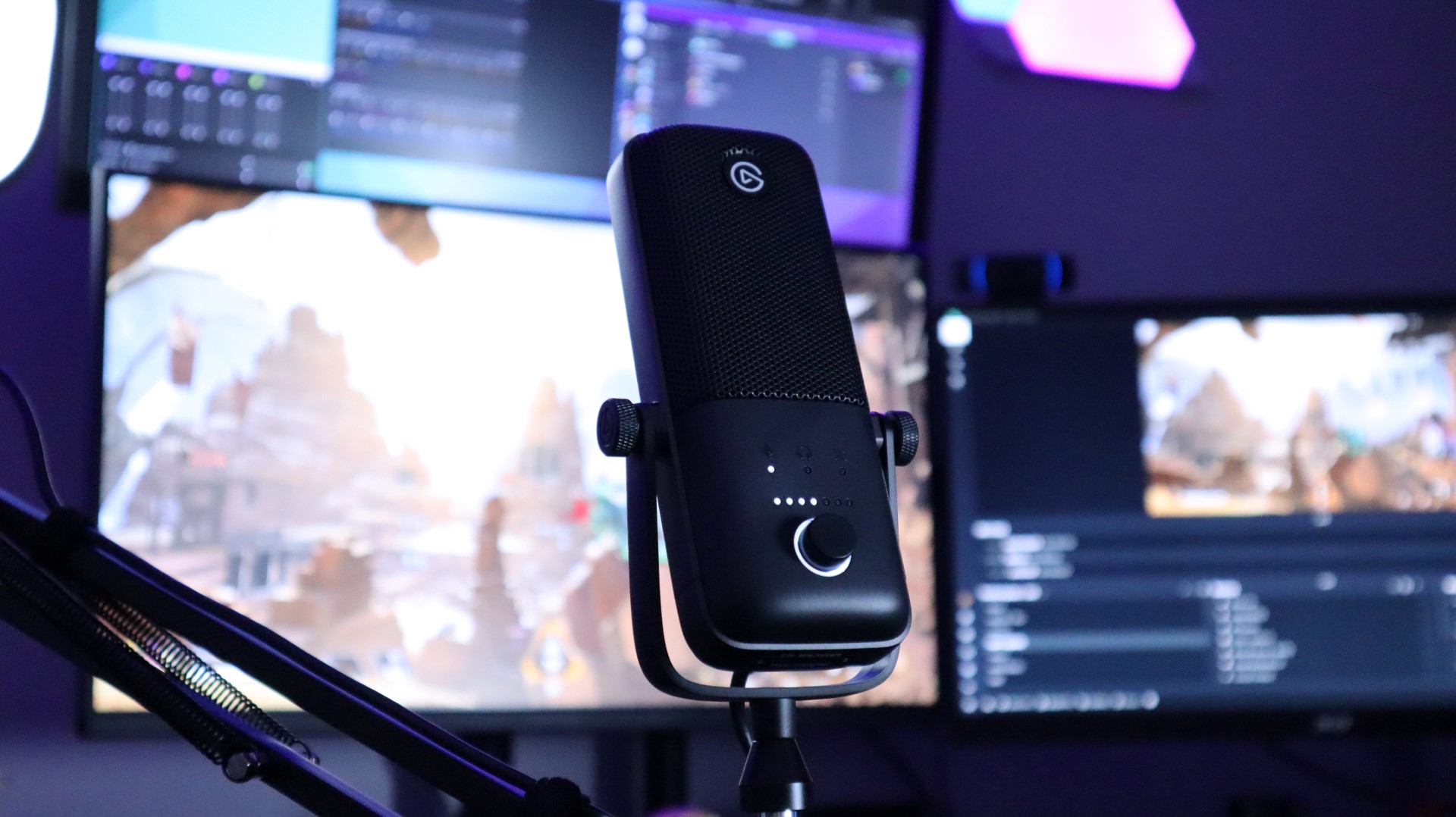Elgato Wave:3 Usage
Installing the Elgato Wave:3 is a simple task, thanks to its USB connectivity and plug-and-play configuration. The included USB-C cable is of good quality, but is a bit stiffer than we would like to see. Once the microphone is connected to your PC or Mac, it will be listed as the “Mic In (Elgato Wave:3)”. These devices can be selected in your audio applications of choice, and once that is set, the Wave:3 is ready to get to work! Obviously this is the case only when using the microphone without Wave Link, which is definitely doable, but you lose out on a tone of options if your intentions are to have advanced control over your audio settings.
Most of our time spend with the Wave:3 has been in gaming sessions and voice chat discussions, and even a little podcasting, and in all instances the microphone performed quite well. When used with the included stand, and placed in front of our keyboard, we did need to use a fairly high gain level in order to fully capture our voice. Once mounted to our microphone arm however, we were able to turn the gain down a bit, as the microphone was much closer to our mouth in this use case.
We used the Wave:3 both in front of and behind our keyboard, and while we did get better results with the microphone in front of our keyboard, it was definitely in the way when typing or playing games. The included stand is nice to have, and does a pretty good job, but we were happy to see the inclusion of a microphone arm adapter to get it up and away from our peripherals and close to our mouth for better pickup.
And while we do appreciate the on-board control dial and LED indicators, we did find that it while live introduced quite a few bumps and other noises in our recordings. That being said, most of these settings are going to be configured once and not touched again, so it really shouldn’t be much of an issue. We also really like the capacitive mute sensor on the top of the microphone, as it makes muting the Wave:3 very quick and easy. The red ring around the control knob is also a nice indicator of mute/live status.
As with nearly all microphones, even those with a Cardioid polar pattern, our peripherals and other ambient noises were certainly picked up by the Wave:3 and transmitted to Wave Link and out of our outputs. Thanks to NVIDIA’s RTX Voice, these ambient noises can be removed from the Wave:3’s audio, but at a cost. You see, in order to use RTX Voice with the Wave:3 and Wave Link, you must utilize a separate input channel in Wave Link. This is a simple process, as you simply click the empty channel to add an input and select “Microphone (NVIDIA RTX Voice)”, however you do lose a few features that are available with just the Wave:3 and Wave Link. In addition to loss of software control over the microphone gain, output volume, and Mic/PC mix, you will also lose the ability to enable or disable the Enhanced Lowcut filter and Clipguard. The lowcut filter removes audio frequencies below 80Hz to help cut down on booming audio, while Clipguard actively monitors the microphone to remove overdriven sound before passing them on to your computer. This is really going to be a matter of personal preference, but we really love the work NVIDIA has done with RTX Voice, so we chose to utilize using that as an additional input channel for the removal of all background noises from our stream.
As we have noted in our previous microphone reviews, the sound quality improvement when moving from a headset-based microphone to a dedicated condenser-style microphone is night and day. Below is a sample audio recording from the Elgato Wave:3, as well as some of our previously reviewed microphones. You can also find us using the Wave:3 as our microphone on the ThinkComputers Weekly Tech Podcast, as well as on our Twitch stream.
Elgato Wave:3
Corsair VOID Pro
Thronmax MDrill One Pro
Samson G-Track Pro
MXL BCD-1
MXL Tempo
HyperX QuadCast
Corsair VOID Pro
Final Thoughts
So, how did Elgato’s first foray into the microphone realm turn out? Quite well actually. The Wave:3 itself provides great audio quality in a compact physical package. And while we were a bit disappointed in the amount of plastic used for the microphone and stand, the overall build quality is quite good. Access to an on-board control knob is nice to have, though it can introduce some unwanted sounds if the microphone is not muted. Thankfully the capacitive mute sensor at the top of Wave:3 works very well, and lets you mute and unmute quickly. The included microphone stand is very sturdy, though it just doesn’t raise the microphone to a height that we deem sufficient. To combat this, Elgato has included a microphone arm adapter which helps get the microphone right in front of your for the best audio pickup. Additional add-on accessories are also available from Elgato, including an external pop filter ($29.99) to compliment the internal filter, and a shock mount ($39.99) for additional audio dampening when used on a microphone arm.
While the Wave:3 is a great microphone by itself, when paired up with the Wave Link application, it really shines. Being able to have full routing and mixing control over multiple audio inputs and outputs lets you customize your audio to your needs. We love having access to this software for our streaming needs, and pairing it up with our Stream Deck gives us easy access to its features without having to switch applications. The only downside to Wave Link that we found was that in order to use RTX Voice with the Wave:3 and Wave Link we had to add that as an additional audio input, which removed our access to the Wave:3’s anti-clipping protection and lowcut filter.
Priced at $159.99, we think the Elgato Wave:3 offers a ton of value. If this price only provided you with the microphone and accessories, we would consider this price a bit high. However, the inclusion of the Wave Link application really expands the capabilities of this microphone and your PC’s streaming audio control to a level where this price almost becomes a bargain. The control over our stream’s audio that we have gained from the Wave:3 and Wave Link has been amazing, and because of that and the great audio quality from the microphone, the Elgato Wave:3 earns a 9 out of 10 and the Editor’s Choice Award.


Pros:
- Great Audio Quality
- Wave Link Audio Mixing and Routing
- Stream Deck Compatibility
- Capacitive Mute Sensor
- On-Board Control Knob and LED Indicators
- USB-C Connectivity
Cons:
- Plastic Construction
- Use With RTX Voice Limits Additional Features From Wave Link






